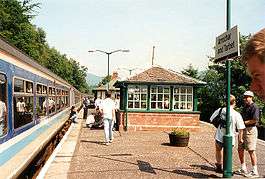Arrochar and Tarbet railway station
| Arrochar & Tarbet | |
|---|---|
| Scottish Gaelic: An t-Arthar & An Tairbeart[1] | |
 View of platform, looking north | |
| Location | |
| Place | Arrochar & Tarbet |
| Local authority | Argyll and Bute |
| Coordinates | 56°12′12″N 4°43′24″W / 56.2033°N 4.7232°WCoordinates: 56°12′12″N 4°43′24″W / 56.2033°N 4.7232°W |
| Grid reference | NN311045 |
| Operations | |
| Station code | ART |
| Managed by | Abellio ScotRail |
| Number of platforms | 2 |
|
Live arrivals/departures, station information and onward connections from National Rail Enquiries | |
| Annual rail passenger usage* | |
| 2012/13 |
|
| 2013/14 |
|
| 2014/15 |
|
| 2015/16 |
|
| 2016/17 |
|
| History | |
| Original company | West Highland Railway |
| Pre-grouping | North British Railway |
| Post-grouping | LNER |
| 7 August 1894 | Opened[2] |
| National Rail – UK railway stations | |
| * Annual estimated passenger usage based on sales of tickets in stated financial year(s) which end or originate at Arrochar & Tarbet from Office of Rail and Road statistics. Methodology may vary year on year. | |
|
| |
Arrochar and Tarbet railway station is a railway station on the West Highland Line in Scotland. It stands between the villages of Arrochar and Tarbet.
History
Opened to passengers on 7 August 1894 by the West Highland Railway, then run by the North British Railway, it became part of the London and North Eastern Railway during the Grouping of 1923. The station then passed on to the Scottish Region of British Railways on nationalisation in 1948. Under NBR and LNER auspices, the station was the terminus of a local service from Craigendoran (Upper) as well as being served by through trains to Fort William and Mallaig. Known as the Wee Arrochar, the Craigendoran service was continued by British Rail until June 1964, when it fell victim to the Beeching Axe.[3]
Between 1945 and 1948 a station and passing loop were located to the east of Arrochar and Tarbet at Inveruglas which served the passenger and freight requirements of the Sloy hydroelectric scheme.
When Sectorisation was introduced in the 1980s, the station was served by ScotRail until the Privatisation of British Rail.
The station was laid out with a crossing loop and an island platform. The sidings on the east side of the station were used for loading timber until December 2008 when the carriage of Scottish timber by rail ceased in connection with the recession. As of June 2015, there is still no sign of the service being reinstated.
When the platform was extended southwards, the redundant signal box was relocated slightly further north for use as a waiting room. In 2000, a replica of the signal box was built in the centre of the island platform, after the station building had to be demolished due to subsidence.
Signalling
From the time of its opening in 1894, the West Highland Railway was worked throughout by the electric token system. Arrochar & Tarbet signal box, which had 17 levers, was situated on the island platform.
The semaphore signals were removed on 19 January 1986 in preparation for the introduction of Radio Electronic Token Block (RETB) by British Rail. The RETB, which is controlled from a Signalling Centre at Banavie railway station, was commissioned between Helensburgh Upper and Upper Tyndrum on 27 March 1988.
After the signal box closed, the lever frame was removed for re-use on the Leadhills and Wanlockhead Railway.
The Train Protection & Warning System was installed in 2003.
Services
Mondays to Saturdays, there are six services to Oban, three to Mallaig (combined with three of the Oban trains) and one service to Fort William (the Highland Caledonian Sleeper) northbound. Southbound, there are six services to Glasgow Queen Street (High Level) and one service to London Euston via Queen Street (Low Level) and Edinburgh Waverley (the Highland Caledonian Sleeper does not run on Saturdays). On Sundays, there are three train northbound to Oban all year and one or two to Mallaig (depending on the time of year) and three trains southbound to Glasgow Queen Street High Level and one to London Euston (which carries seating carriages as well as sleeper coaches and calls at Queen Street Low Level and Edinburgh to set down).[4]
| Preceding station | Following station | |||
|---|---|---|---|---|
| Garelochhead | Abellio ScotRail West Highland Line |
Ardlui | ||
| Garelochhead | Caledonian Sleeper Highland Caledonian Sleeper |
Ardlui | ||
| Historical railways | ||||
| Glen Douglas Halt Line open; Station closed |
West Highland Railway North British Railway |
Ardlui Line and Station open | ||
References
| Wikimedia Commons has media related to Arrochar and Tarbet railway station. |
Notes
- ↑ Brailsford 2017, Gaelic/English Station Index.
- ↑ Butt (1995), page 19
- ↑ "The 'Wee Arrochar'"Helensburgh Heritage Trust website; Retrieved 16 May 2016
- ↑ GB eNRT 2015-16 Edition, Table 227
Sources
- Brailsford, Martyn, ed. (December 2017) [1987]. Railway Track Diagrams 1: Scotland & Isle of Man (6th ed.). Frome: Trackmaps. ISBN 978-0-9549866-9-8.
- Butt, R. V. J. (1995). The Directory of Railway Stations: details every public and private passenger station, halt, platform and stopping place, past and present (1st ed.). Sparkford: Patrick Stephens Ltd. ISBN 978-1-85260-508-7. OCLC 60251199.
- Jowett, Alan (March 1989). Jowett's Railway Atlas of Great Britain and Ireland: From Pre-Grouping to the Present Day (1st ed.). Sparkford: Patrick Stephens Ltd. ISBN 978-1-85260-086-0. OCLC 22311137.
- Jowett, Alan (2000). Jowett's Nationalised Railway Atlas (1st ed.). Penryn, Cornwall: Atlantic Transport Publishers. ISBN 978-0-906899-99-1. OCLC 228266687.
- RAILSCOT on the West Highland Railway
- Station on navigable O.S. map